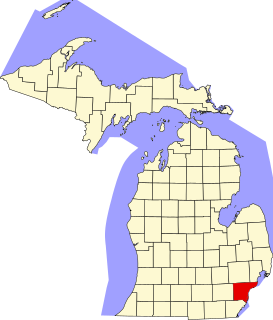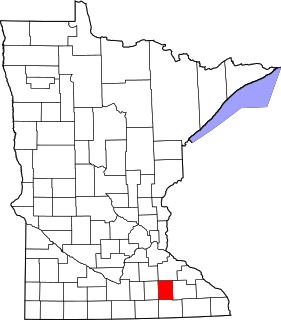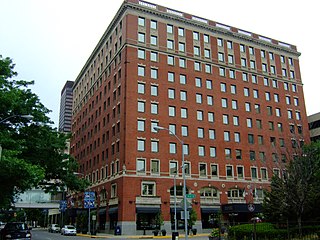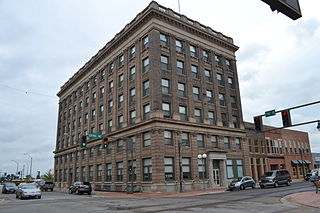
Fort Dodge is a city in, and the county seat of, Webster County, Iowa, United States, along the Des Moines River. The population was 24,871 in the 2020 census, an decrease from 25,136 in 2000. Fort Dodge is a major commercial center for North Central and Northwest Iowa. It is located on U.S. Routes 20 and 169.

This is a list of properties and districts listed on the National Register of Historic Places in Wisconsin. There are over 2,400 listed sites in Wisconsin. Each of the state's 72 counties has at least one listing on the National Register.

This is a list of the National Register of Historic Places listings in Wayne County, Michigan.

This is a list of the National Register of Historic Places listings in Detroit, Michigan.

The Webster County Courthouse is a historic building in Fort Dodge, Iowa, United States. Built in 1902, it primarily houses local government offices for Webster County. The courthouse is the second building the county has used for court functions and county administration. It was individually listed on the National Register of Historic Places in 1981, and as a contributing property in the Fort Dodge Downtown Historic District in 2010.
In the United States, the National Register of Historic Places classifies its listings by various types of architecture. Listed properties often are given one or more of 40 standard architectural style classifications that appear in the National Register Information System (NRIS) database. Other properties are given a custom architectural description with "vernacular" or other qualifiers, and others have no style classification. Many National Register-listed properties do not fit into the several categories listed here, or they fit into more specialized subcategories.

This is a list of the National Register of Historic Places listings in Dodge County, Minnesota. It is intended to be a complete list of the properties and districts on the National Register of Historic Places in Dodge County, Minnesota, United States. The locations of National Register properties and districts for which the latitude and longitude coordinates are included below, may be seen in an online map.

Fort Armstrong Hotel is a historic building located in downtown Rock Island, Illinois, United States. It was individually listed on the National Register of Historic Places in 1984. In 2020 it was included as a contributing property in the Downtown Rock Island Historic District. The hotel was named for Fort Armstrong, a fortification that sat in the middle of the Mississippi River near the present location of the Rock Island Arsenal. The building now serves as an apartment building.

Liebbe, Nourse & Rasmussen was an architectural firm in the U.S. state of Iowa. Their Kromer Flats was built in 1905. It designed a number of buildings that are listed on the U.S. National Register of Historic Places.

The Hotel Fort Des Moines is an historic building located in downtown Des Moines, Iowa, United States. It was listed on the National Register of Historic Places in 1982.

The Savery Hotel, now known as the Renaissance Des Moines Savery Hotel, is a historic building located in downtown Des Moines, Iowa, United States. This is the third hotel in the city with that name and the second at this location. The prominent Chicago hotel design firm H.L. Stevens & Company designed the 233-room hotel in the Colonial Revival style, which was a rare choice for commercial architecture in Des Moines. The hotel is an eleven-story brick building that rises 140 feet (43 m) above the ground. Opened in 1919, it has additions completed in 1952 and 1953. Across the alley to the west is an annex that was completed c. 1899 for the previous hotel building. During World War II, Des Moines was the location for the first Women's Army Auxiliary Corps (WAAC) training center. The Savery augmented the facilities at Fort Des Moines and served as the induction center, barracks, mess hall, and classrooms from 1942 to 1945.

The First National Bank Building, now known as the Central Place Apartments, is an historic building located in Fort Dodge, Iowa, United States. The First National Bank was established in 1866 and grew to become the city's principal financial institution. Its officers and directors throughout its existence were among the city's most prominent businessmen. The present building was designed by the Des Moines architectural firm of Liebbe, Nourse & Rasmussen in the Early Commercial style. The six-story structure rises to a height of 90 feet (27 m) The building has subsequently been renovated into apartments. It was individually listed on the National Register of Historic Places in 2003, and as a contributing property in the Fort Dodge Downtown Historic District in 2010.

The Moorehead Stagecoach Inn is a historic building located in Ida Grove, Iowa, United States. The Western Stage Line began to operate stagecoaches from Lizzard Point to Sergeant Bluff in 1855. The following year John H. Moorehead began building this inn. It was completed in 1863, and it was the first building constructed in Ida Grove. It is a 1½-story, L-shaped, frame structure with twelve rooms. The building served a variety of purposes in its early days. Two years after Ida County was organized it became the county courthouse and remained so until 1871. The building also housed the post office, as well as religious, educational, and commercial purposes.

Greenfield Public Square Historic District is a nationally recognized historic district located in Greenfield, Iowa, United States. It was listed on the National Register of Historic Places in 2014. At the time of its nomination the district consisted of 52 resources, including 42 contributing buildings, one contributing site, six noncontributing buildings, and three noncontributing objects. The historic district covers part of the city's central business district in the center of the original town plat. There is a significant number of one- and two-story, brick, commercial buildings, as well as a few three-story structures. The Commercial Italianate style is dominant. While the vast majority of the buildings are commercial buildings, there are four government buildings in the district: the Adair County Courthouse (1892), public library (1916), city hall (1930), and the municipal light plant (1940). Besides the courthouse, the other buildings that are individually listed on the National Register include Warren Opera House Block and Hetherington Block (1896), Adair County Democrat-Adair County Free Press Building (1903), and the Hotel Greenfield (1920).

The former Fort Dodge Senior High School building, also known as North Junior High and Phillips Middle School, is a historic building located in Fort Dodge, Iowa, United States. The building was constructed in 1922 with additions completed in 1948 and 1979. When the current high school was built in 1958, this building became known as North Junior High School, housing grades 7, 8, and 9. The Fort Dodge Community School District's adoption of the middle school philosophy in 1984 changed the name of the building to Phillips Middle School. District-wide grade reconfiguration in 1990 changed Phillips to a building housing grades 7 and 8. It, along with Fair Oaks Middle School, was sold to Foutch Bros. LLC, of Kansas City, Missouri the following year to be converted into apartments. The building was listed on the National Register of Historic Places in 2015.

Fort Dodge Downtown Historic District is a nationally recognized historic district located in Fort Dodge, Iowa, United States. It was listed on the National Register of Historic Places in 2010. Additional documentation for the district was approved by the National Park Service on January 4, 2019. At the time of its nomination it contained 177 resources, which included 100 contributing buildings, one contributing site, one contributing structure, five contributing objects, 64 non-contributing buildings, three non-contributing structures, and three non-contributing objects. The district covers the city's central business district, mainly along Central Avenue, but also along the adjoining streets as well. Commercial development in the district began with the city's original plat in 1854 and continued through the opening of the Crossroads Mall in 1964. Webster County Courthouse (1902), First National Bank Building (1908), and the Wahkonsa Hotel (1910) are all located in the district and are individually listed on the National Register.

Hotel Lester-Lester Cafe, also known as the Dodge House-Long Branch, is a historic building located in Mason City, Iowa, United States. Its construction, completed in 1915, was a project undertaken by local real estate developer Meir Wolf. It was built as a two-story building a block away from the passenger and freight depots of the Chicago and North Western Railroad and the Chicago Great Western Railway. The building was meant to be used as a railroad hotel so passengers and rail employees would not have to travel the six to eight blocks to the hotels downtown. It is the only remaining railroad hotel left in Mason City. Hotel guests stayed in the 29 rooms on the second floor, and three commercial spaces on the first floor were occupied by a variety of restaurants, grocery stores and barbershops. Its most famous guest was track star Jesse Owens, who was in town in December 1937 for a basketball exhibition. He could not stay at the other hotel's in town because of his race. In 1975 the hotel's name was changed to the Dodge House and the Long Branch Saloon occupied the space that had previously housed a cafe. By that time it was largely used as a rooming house, and it was used to house the homeless. The building was listed on the National Register of Historic Places in 2002.

The Lewis System Armored Car and Detective Service Building, also known as the Bell Tire and Rubber Company and Sioux City Tent and Awning, is a historic building located in Sioux City, Iowa, United States. F.A. Martin and Richard Nash, who owned the property, had this two-story brick commercial building constructed in 1929. KB Construction, who built the building, occupied the second floor. Bell Tire and Rubber Company was the first business located on the first floor from 1930 to 1933. A few other businesses occupied the space until Sioux City Tent and Awning was located here from 1937 to 1941. The following year Lewis System moved in and remained until 1969. The second floor was converted into apartments about 1950.

Ames Main Street Historic District is a nationally recognized historic district located in Ames, Iowa, United States. It was listed on the National Register of Historic Places in 2018. At the time of its nomination it consisted of 81 resources, which included 76 contributing buildings, and 15 non-contributing buildings. The district covers most of the city's central business district. The area began to develop after the Civil War along the Chicago and North Western (CNW) tracks. The district was also served by the Ames & College Railway and its successor, the Fort Dodge, Des Moines, & Southern Interurban Streetcar line, from 1891 to 1929. The later connected downtown Ames and the CNW depot with Iowa State College, now known as Iowa State University.




















